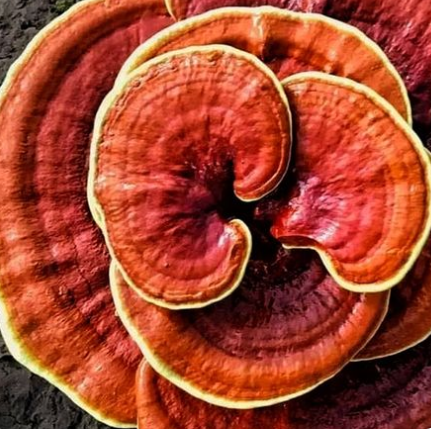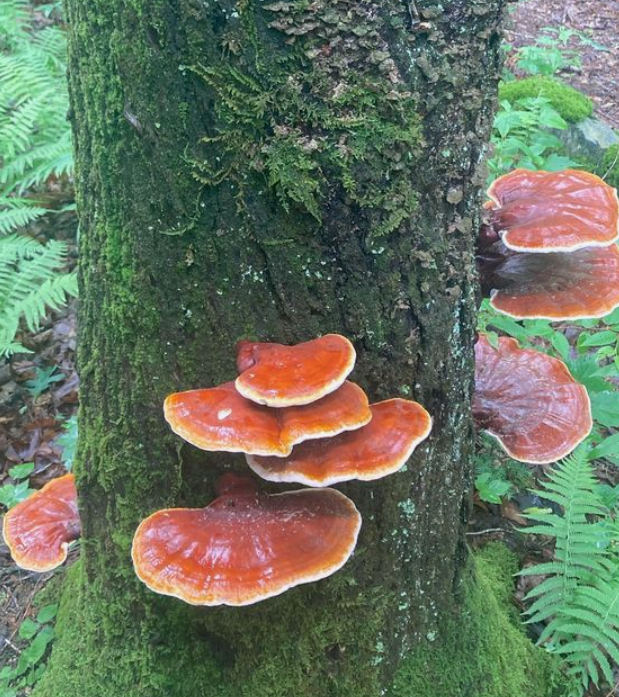11 Benefits of Reishi Mushrooms
Sometimes referred to as the “mushroom of immortality,” reishi has been used for thousands of years to promote vitality, support immune function, maintain stress resilience, deepen mental clarity and more.
Once rare and mostly reserved for the Chinese emperor and his court, these days it’s widely cultivated and available for those of us whose royal titles only go so far as “Queen of Laundry.”
As you might have guessed by its nickname, it’s traditionally thought to promote longevity, and modern research has yielded some interesting findings in animal studies.
This study, for example, found that mice given reishi extract experienced a 9-20% increase in lifespan. That’s equivalent to roughly 7-16 years in human terms. Of course, human studies are needed to confirm whether this effect also applies to people, but those will take time to complete since human lifespans are much longer than those of mice.
In the meantime, there’s lots of high-quality research on reishi’s other traditional benefits. Rich in over 400 bioactive compounds that work together, it’s one of the most studied of the “medicinal mushrooms.” (1)
We’ll talk more about its amazing bioactive compounds in a moment, but first a quick note: None of these statements have been evaluated by the FDA, this article is not medical advice, and it is not meant to diagnose or treat any condition. If you have a question about whether reishi (or any other supplement) is right for you, please talk with a qualified healthcare provider. Okay, let’s dive in!
what is the reishi mushroom?
Reishi is identified by its shiny, plastic-looking fruiting body. It almost looks fake, like a mushroom that belongs on a stage set, which is how it earned another of its nicknames, ‘the varnished conk’ (conk is another name for the fruiting body of some tree-consuming fungi.” – Tero Isokauppila, author of Healing Mushrooms
Also called lingzhi, the reishi mushroom (Ganoderma lucidum) grows mostly on dead or dying eastern hemlock trees, and ranges in color from reddish-orange to purple to black. The fruiting body (shiny part) and mycelium (threadlike filaments that are similar to roots) have long been used to make beneficial teas, tinctures, and powders.
While young reishi can be eaten fresh, mature reishi has woody, cork-like texture that’s, uh, not as appealing as mushrooms like lion’s mane, which happens to be tender and taste a little like crab meat.
That’s why in Traditional Chinese Medicine, the fruiting part of the reishi mushroom is typically dried, cut into slices, boiled and steeped to release its beneficial compounds. Hot water is particularly good at extracting its valuable polysaccharides, which are renowned for their therapeutic properties. Red reishi is usually preferred because it tends to be higher in polysaccharides than other varieties. (2)
Unfortunately, hot water extracts leave behind valuable compounds such as triterpenes, which support our ability to utilize oxygen, immune function, liver function and more. Alcohol is better at pulling out triterpenes and other select compounds, which is why my favorite store-bought and homemade reishi extracts use both water and alcohol.
Known as dual extractions, these reishi powders and tinctures yield a wider variety of compounds than is possible with either a solo water or solo alcohol extract. I’ll share some recommended products below, and I’ll also be publishing a step-by-step guide to making dual extractions in the next few weeks.
Reishi Mushroom’s Bioactive Compounds
As I mentioned earlier, reishi contains roughly 400 bioactive compounds that work synergistically together. Rather than dive into all of them here, let’s take a look at the ones that play a primary role in reishi’s beneficial effects.
Polysaccharides: A “Therapeutically Active Compound”
In Medicinal Mushrooms: A Clinical Guide, Martin Powell writes:
Polysaccharides are not the sole category of therapeutically active compound present in mushrooms but they are the most widespread, and, in many but not all mushrooms, the most important with a profound impact in the immune system mediated by a number of fungal polysaccharide-specific receptors on the surface of several classes of immune cell.”
In other words, our cells have receptors that are specifically designed to work with the kinds of polysaccharides generated by mushrooms, leading Powell to conclude that they might be “essential nutrients for our immune system.”
In addition to their immune supporting benefits, polysaccharides such as beta-glucans also:
- Have a prebiotic effect that supports gut health (3)
- Support autophagy (Cellular cleanup mode) (4)
- Support healthy blood pressure (2)
- Encourage healthy blood sugar levels (2)
- Help optimize cholesterol levels (2)
Triterpenes for Healthy Cells, Increased Oxygenation & More
Reishi contains somewhere between 140-200 triterpenes, including lucidenic and ganoderic acid, lipid alkaloids, coumarins and sterols. Taken together, these triterpenes:
- Have adaptogenic and adrenal supporting properties, which means they help our bodies maintain resilience during times of stress
- Optimize and balance immune function (
- Encourage a balanced histamine response, which may be helpful for people with seasonal allergies or histamine intolerance
- Support heart health, circulation and healthy cholesterol levels
- Optimize the body’s ability to use oxygen
- Support autophagy
Antioxidants (AKA Free Radical Scavengers)
We know that excessive amounts of free radicals – which our bodies produce as byproducts of metabolism – cause oxidative stress that can lead to accelerated aging and several disease processes.
Fortunately, as this Live Science article puts it,
Antioxidants are able to give an electron to a free radical without becoming destabilized themselves, thus stopping the free radical chain reaction. ‘Antioxidants are natural substances whose job is to clean up free radicals. Just like fiber cleans up waste products in the intestines, antioxidants clean up the free radical waste in the cells,’ said Wright.”
Reishi contains several antioxidants – quercetin, rutin, myricetin and morin – which help counteract oxidative stress.
11 Benefits of Reishi Mushrooms
Reishi has been the subject of extensive research, and in discussing the bioactive compounds above we’ve just barely touched on its health benefits.
After reading Healing Mushrooms by Four Sigmatic founder Tero Isokauppila, it became a staple in my kitchen along with others like chaga, lion’s mane, oyster mushrooms and cordyceps.
1. Activates “Cleanup Mode”
The polysaccharides and triterpenes in reishi promote autophagy, which literally translates as “cellular eating.”As I mention in this article on intermittent fasting, during autophagy a bunch of little guys called lysosomes go around gobbling up damaged cells, damaged mitochondria, and cancerous cells. These lysosomes and mitochondria are good guys, giving us energy for vitality and cellular regeneration for a vibrant life.
Without them, our body fills up with cellular trash and we just can’t function as optimally as possible.
2. Youthful Skin
The compounds in reishi work both externally and internally to keep you looking young by reducing dermal oxidation (which is when proteins on the skin are damaged, causing wrinkles and other signs of aging) and protecting your cellular DNA and mitochondria from oxidant damage as well, allowing you to remain energized, alert, and feeling refreshed.” – Tero Isokauppila, Healing Mushrooms (2)
3. Immune Support & Balance
Reishi’s adaptogenic properties help to stabilize your immune system so that it operates at its full potential.” – Tero Isokauppila, Healing Mushrooms (2)
Ethnobotanist David Winston and herbal expert Steven Maimes agree, writing that it supports “monocyte, macrophage, and T lymphocyte activity” while helping to calm an overactive response. (9)
Beta-glucans and triterpenes are both thought to contribute to reishi’s balancing effect on immune function. (21)
4. Hormone Balance
Another major benefit of reishi, and what truly puts it in a class of its own, is how it works to achieve hormone balance. The specific triterpene compounds in reishi fruiting bodies support and balance the endocrine system.
When you have an optimally functioning hormonal system (and surprisingly few do – for a slew of reasons including the impact of environmental toxins and the overprescribing of prescription medications, among a host of other factors), your body can relax and recover during the night as it is meant to. Taking reishi will not only increase your quality and duration of deep, restful sleep but will also allow you to function at peak levels during waking hours.” – Tero Isokauppila, Healing Mushrooms (2)
5. Restful Sleep
Reishi is traditionally used to support healthy sleep cycles, and animal research supports this effect. In this study on rats, reishi mushrooms significantly reduced the time it took to fall asleep while increasing total sleep time.
6. Stress Relief, Mental Clarity & Energy
Reishi is an adaptogen, or fungi/plant that helps maintain resilience during stressful times, supports energy and stamina, and helps with mental clarity.
In Adaptogens in Medical Herbalism: Elite Herbs and Natural Compounds for Mastering Stress, Aging and Chronic Disease, Donald Yance, CN, MH, RH(AHG) describes it as “the perfect remedy for the typical American suffering from constant stress.”
Several studies have also concluded that it reduced fatigue in participants with stressed-out nervous systems.
7. May Have Neuroprotective Effects
Animal studies suggest that reishi may promote the production of nerve growth factor and have other neuroprotective properties. However, more research is needed to confirm this effect in humans.
8. Gut Health
Recent research indicates that mushroom polysaccharides have a prebiotic effect on the gut microbiome with increases in Bifidobacterium and Lactobacillus species and decreases in Clostridium, Staphylococcus, and Enterococcus species . . . and it has been suggested that this effect may also contribute to their diverse health benefits.” Medicinal Mushrooms: A Clinical Guide
In other words, polysaccharides may serve as food for beneficial gut bacteria while also promoting a healthy immune system.
9. Helps Support Healthy Liver Function
In a study published in the journal Food and Chemical Toxicology, researchers reported that mice who consumed reishi spores maintained healthy liver function when they were exposed to cadmium, a toxic heavy metal known to cause liver damage. (15)
In a study done with humans, volunteers who received reishi had higher levels of antioxidant enzymes and lower levels of compounds that indicate liver stress or inflammation. (16)
Additional research has concluded that the polysaccharides found in reishi may have a rejuvenating effect on liver antioxidant systems after an infection. (17) (18)
10. Allergy Support
Triterpenes found in reishi encourage a balanced histamine response, which may be helpful for people with seasonal allergies or histamine intolerance This may be because reishi has a calming effect on histamine release.
11. Cardiovascular Support
More research is needed, but “reishi supplementation for cardio benefits is commonly practiced in Asia, and the preliminary studies with humans are encouraging.” (16)
As I mentioned in the section on polysaccharides above, reishi is thought to:
- Support healthy blood pressure (2)
- Encourage healthy blood sugar levels (2)
- Help optimize cholesterol levels (2)
What’s the best way to consume reishi?
When choosing a reishi tea, tincture or powder, there are three main things to consider:
1. What part is used ? (fruiting body or mycelium)
The fruiting body is considered to have the most potent therapeutic effect, however many products just use the mycelium because it grows faster.
2. What’s the reishi grown on? (logs, grain, or sawdust)
Many mushroom products are mycelium (the less potent part) grown on grain (often gluten-containing rye or wheat) or logs/sawdust. When considering different products, I look for ones that use the fruiting body and are grown on whole logs or ground logs (sawdust).
4. What type of extract is it?
The two basic types are water and alcohol. Water extracts valuable polysaccharides, while alcohol extracts triterpenes and other beneficial compounds.
Which one is desirable depends on what your goals are. Personally, I opt for dual-extraction products that use the fruiting body instead of the mycelium.
Recommended Reishi Products
I love these Reishi 415 capsules from Real Mushrooms. They’re dual-extracted and made from 100% organic reishi fruiting bodies with no added starch, mycelium, or grain of any kind.
Four Sigmatic elixirs are also dual extracted from fruiting bodies and contain no fillers.
Here are some of the options I’ve tried and liked. Use code MP15 for 15% off.
- Reishi Elixir (1500mg reishi extract, caffeine-free)
- Mushroom Hot Cacao With Reishi (500 mg reishi extract)
- Chai Latte With Turkey Tail & Reishi (300 mg turkey tail extract, 200 mg reishi extract)
- 10 Mushroom Blend (160 mg each of meshima extract, reishi extract, chaga extract, cordyceps extract, enokitake extract, maitake extract, lion’s mane extract, tremella extract, and agaricus extract)
Growing Reishi
The gorgeous, antler-shaped red reishi you see in the photo above was grown using this kit, which basically requires zero effort but takes time to mature. It comes sealed inside a clear bag which provides the perfect ecosystem for it, so you just put the bag in bright indirect sunlight and leave it alone until you’re ready to harvest. There’s no need to mist it with water at all.
Making A Dual Extraction Tincture
Dual extraction tinctures allow you to get the best of both worlds – water soluble polysaccharides, alcohol soluble triterpenes and other valuable constituents. In the next few weeks I’ll be publishing a step-by-step guide for doing just that with a video.
Reishi Tea Recipe
If your main goal is to extract reishi’s polysaccharides, this method will do the trick:
- 1-2 ounces dried, chopped red reishi (by weight)
- 4 cups of water
- Add reishi and water to a medium pot and bring to a simmer.
- Continue to simmer, uncovered, for at least two hours. By the end of two hours the liquid should reduce by about half. If it looks like too much is evaporating as it simmers, add more water.
- Strain out the reishi and serve.
In Adaptogens: Herbs for Strength, Stamina and Stress Relief, ethnobotanist David Winston and herbal expert Steven Maimes suggest up to 3-4 cups per day.
Reishi Tincture Recipe
To make a 1:5 tincture, which is recommended in Adaptogens: Herbs for Strength, Stamina and Stress Relief, you’ll need:
- 1 ounce dried reishi reishi slices (by weight)
- 5 ounces of 60 proof or higher vodka (by volume)
To make reishi tincture:
- Place dried reishi in a clean jar. Cover completely with vodka, then secure the lid and shake well. If desired, write the start date on the jar using a sticky note, label, or piece of tape – it makes keeping track of how long it’s been steeping easier.
- Place the jar in a dark area that is relatively warm. (I keep mine in a kitchen cabinet.) Let the mixture steep for 6-8 weeks.
- When it’s ready, strain the mixture through a cheesecloth, making sure to squeeze out as much liquid as possible. Pour the liquid in a clean container and store in a cool, dark area.
To use reishi tincture: Winston and Maimes recommend 80-100 drops, four to six times per day. Another option is to purchase a pre-made reishi tincture and follow the instructions on the label after talking with your healthcare provider.
Safety Considerations
According to the Botanical Safety Handbook: 2nd Edition, reishi is a Safety Class 1A herb – the safest rating possible. This category is described as:
Herbs that can be safely consumed when used appropriately.
- History of safe traditional use
- No case reports of significant adverse events with high probability of causality
- No significant adverse events in clinical trials
- No identified concerns for use during pregnancy or breastfeeding
- No innately toxic constituents
- Toxicity associated with excessive use is not a basis for exclusion from this class
- Minor or self-limiting side effects are not bases for exclusion from this class
However, I did find one caution worth adding, which is that “Reishi supplements may cause anticoagulants or antiplatelets to become more effective, which increases the risk of bleeding. Therefore, people whom doctors have scheduled for surgery and individuals with bleeding disorders should not take reishi mushrooms.” (20) (emphasis mine)
Always check with your doctor before adding herbs to your diet, and listen to your intuition to help you make the best choice for yourself. For a more in-depth discussion of opinions regarding the use of adaptogens during pregnancy/breastfeeding

Sources
- Sanodiva, BS et. al. (2009) Ganoderma lucidum: a potent pharmacalogical macrofungus
- Isokauppila, Tero (2017) Healing Mushrooms
- Jayachandran, Muthukumaran et. al. (2017) A Critical Review on Health Promoting Benefits of Edible Mushrooms through Gut Microbiota
- Pan, Haito et. al. (2019) Autophagic flux disruption contributes to Ganoderma lucidum polysaccharide-induced apoptosis in human colorectal cancer cells via MARK/ERK activation
- Thyagarajan, A et. al. (2010) Triterpenes from Ganoderma lucidum induce autophagy in colon cancer through the inhibition of p38 mitogen-activated kinase
- You, Bang-Jau et. al. (2013) A Novel Approach to Enhancing Ganoderic Acid Production by Ganoderma lucidum Using Apoptosis Induction
- Saltarelli, R et. al. (2015) Biochemical characterization and antioxidant and antiproliferative activities of different Ganoderma collections
- Liu, Yuh-Hwa et. al. (2015) Effect of hot water extracts from Ganoderma lucidum residues and solid-state fermentation residues on prebiotic and immune-stimulatory activities in vitro and the powdered residues used as broiler feed additives in vivo
- Winston, David and Maimes, Steven (2007) Adaptogens: Herbs for Strength, Stamina and Stress Relief
- Yance, Donald (2013) Adaptogens in Medical Herbalism: Elite Herbs and Natural Compounds for Mastering Stress, Aging and Chronic Disease
- Tang, Wenbo et. al. (2005) A randomized, double-blind and placebo-controlled study of a Ganoderma lucidum polysaccharide extract in neurasthenia
- Aguirre, Moreno et. al. (2013) Anticonvulsant and Neuroprotective Effects of Oligosaccharides from Lingzhi or Reishi Medicinal Mushroom, Ganoderma lucidum (Higher Basidiomycetes)
- Sun, Xin-zhi et. al. (2017) Neuroprotective effects of ganoderma lucidum polysaccharides against oxidative stress-induced neuronal apoptosis
- Zhou, Y et. al. (2012) Neuroprotective effect of preadministration with Ganoderma lucidum spore on rat hippocampus
- Jin, Hai et. al. (2013) Protective effects of Ganoderma lucidum spore on cadmium hepatotoxicity in mice
- Hobbs, Christopher (2021) Christopher Hobbs’s Medicinal Mushrooms
- Kim, DH et. al. (1999) Beta-glucuronidase-inhibitory activity and hepatoprotective effect of Ganoderma lucidum
- Basinska, A and Florianczyk, B (2003) Beta-glucuronidase in physiology and disease
- Tasaka, K et. al. (1988) Anti-allergic constituents in the culture medium of Ganoderma lucidum. (II). The inhibitory effect of cyclooctasulfur on histamine release
- Medical News Today. Everything You Need To Know About Reishi Mushrooms
- Powel, Martin (2014) Medicinal Mushrooms: A Clinical Guide
source: https://mommypotamus.com/reishi-mushroom-benefits-uses/
Terms of Use:The information presented on the network is intended to expand personal knowledge and provide general understanding in a variety of fields to help you be active your Creative freedom and nurturing your health. The information presented here does not pretend to be and is not a substitute for medical instructions. Everything presented on the network is the personal opinion of the writers and any decision regarding your action or health choice is your sole responsibility. with regards For complete inner freedom.
Outhematrix (out the matrix) Network management.








